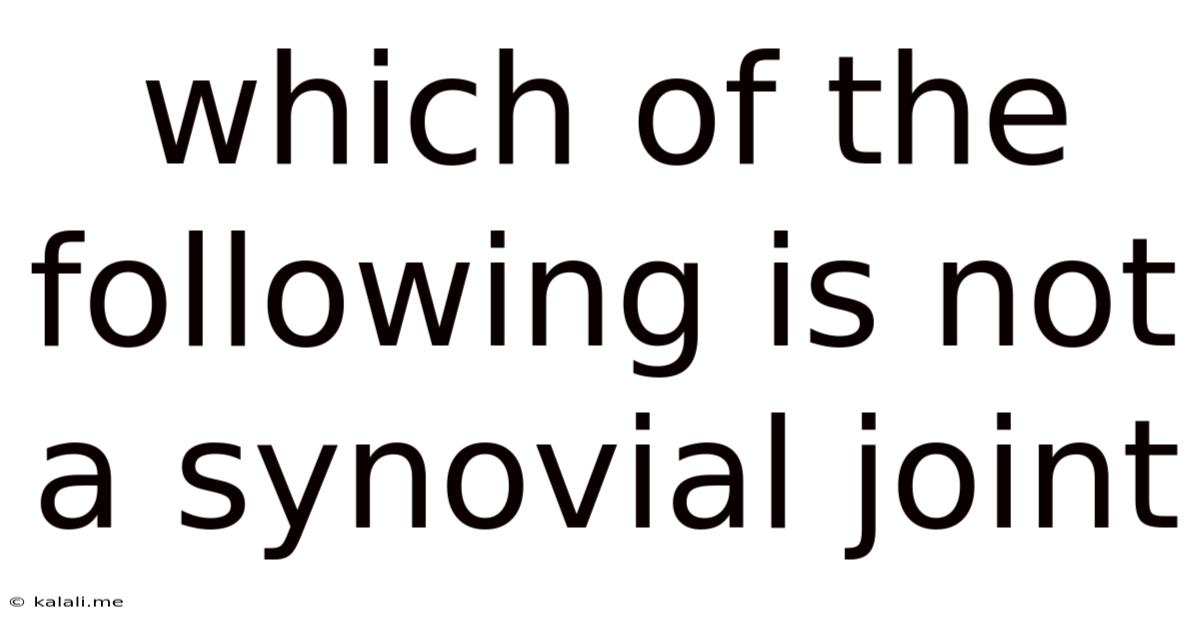Which Of The Following Is Not A Synovial Joint
Kalali
Jun 11, 2025 · 3 min read

Table of Contents
Which of the Following is NOT a Synovial Joint? Understanding Joint Classification
This article will explore the different types of joints in the human body, focusing specifically on synovial joints and identifying which joint type does not fall under this category. Understanding joint classification is crucial for comprehending human movement and potential musculoskeletal issues. We'll delve into the characteristics of synovial joints and contrast them with other joint types to solidify your understanding.
What are Synovial Joints?
Synovial joints are characterized by their unique structure, enabling a wide range of motion. Key features include:
- Synovial Cavity: A fluid-filled space separating the articulating bones. This cavity is crucial for reducing friction during movement.
- Articular Cartilage: A smooth, hyaline cartilage covering the ends of the bones. This cartilage acts as a shock absorber and further minimizes friction.
- Synovial Fluid: A viscous fluid within the synovial cavity that lubricates the joint and provides nourishment to the cartilage.
- Joint Capsule: A fibrous capsule that encloses the joint, providing stability and support.
- Ligaments: Strong, fibrous connective tissues that reinforce the joint capsule and limit excessive movement. They play a crucial role in joint stability.
Types of Synovial Joints: Synovial joints are further categorized based on their shape and the type of movement they allow. Common examples include:
- Ball-and-Socket Joints (e.g., shoulder, hip): Allow for the widest range of motion, including flexion, extension, abduction, adduction, rotation, and circumduction.
- Hinge Joints (e.g., elbow, knee): Allow movement primarily in one plane, like flexion and extension.
- Pivot Joints (e.g., atlantoaxial joint): Allow rotation around a single axis.
- Condyloid Joints (e.g., wrist): Allow movement in two planes, flexion/extension and abduction/adduction.
- Saddle Joints (e.g., thumb carpometacarpal joint): Allow movement in two planes with a slight degree of rotation.
- Gliding Joints (e.g., intercarpal and intertarsal joints): Allow for sliding or gliding movements between bones.
Non-Synovial Joints: The Contrast
In contrast to the freely movable synovial joints, non-synovial joints have limited or no movement. These joints are further categorized into:
- Fibrous Joints: These joints are connected by fibrous connective tissue, offering little to no movement. Examples include sutures in the skull and the joint between the tibia and fibula. These joints are characterized by their strong, inflexible nature, providing stability rather than mobility.
- Cartilaginous Joints: These joints are connected by cartilage, allowing for slight movement. Examples include intervertebral discs and the pubic symphysis. They offer a balance between stability and limited flexibility.
Answering the Question
Therefore, any joint that isn't characterized by a synovial cavity, articular cartilage, synovial fluid, and a joint capsule would not be a synovial joint. Examples of joints that are not synovial joints include fibrous joints like sutures in the skull and cartilaginous joints like the intervertebral discs. The specific answer to "which of the following is not a synovial joint" would depend on the options provided in a given question. However, by understanding the defining features of synovial joints, you can easily identify non-synovial joint types. The key is to look for the absence of the characteristic features described above.
Latest Posts
Latest Posts
-
What Kind Of Room Has No Doors Or Windows
Jul 01, 2025
-
How Many Cups Of Elbow Macaroni Are In A Pound
Jul 01, 2025
-
How Many Guppies In A 5 Gallon Tank
Jul 01, 2025
-
How To Beat Stage 7 In Bloxorz
Jul 01, 2025
-
How Much Oz In A Bottle Of Water
Jul 01, 2025
Related Post
Thank you for visiting our website which covers about Which Of The Following Is Not A Synovial Joint . We hope the information provided has been useful to you. Feel free to contact us if you have any questions or need further assistance. See you next time and don't miss to bookmark.